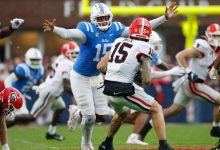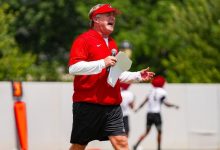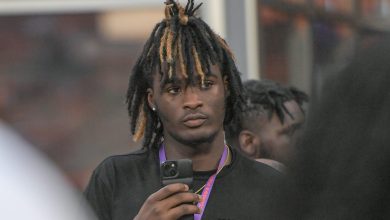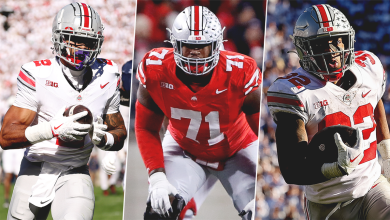The complexity of the new Bears defense caught Montez Sweat by surprise, challenging his usual pass-rushing approach significantly.

The NFL offseason often brings about significant changes in team dynamics, schemes, and personnel, and the Chicago Bears have not been immune to such transformations. One of the most talked-about developments this year is the Bears’ revamped defensive scheme, which has notably caught veteran pass rusher Montez Sweat by surprise. Known for his aggressive and explosive style, Sweat has faced new challenges adapting to a more complex and nuanced Bears defense. This article dives deep into the layers of this defensive overhaul, Sweat’s reaction, and what it means for the Bears moving forward.
Who is Montez Sweat?
Montez Sweat entered the NFL as a highly touted edge rusher, drafted by the Washington Commanders in the first round of the 2019 NFL Draft. Renowned for his athleticism, speed, and relentless motor, Sweat quickly became a premier pass-rushing threat. His style is characterized by a straight-ahead, power-and-speed approach designed to overpower offensive tackles and disrupt quarterbacks.
Sweat joined the Chicago Bears via trade during the 2023 season, expected to bolster the team’s pass rush and help improve a defense in transition. Coming into the Bears organization, Sweat was regarded as a high-impact player capable of transforming the defensive front.
The Bears’ Defensive Overhaul
Under new defensive coordinator Alan Williams, the Bears have shifted from a relatively straightforward 4-3 base defense to a more complex, hybrid system that blends multiple fronts, zone coverages, and disguised blitz packages. This strategic evolution aims to:
- Increase unpredictability: By frequently shifting looks pre-snap, confusing offensive lines and quarterbacks.
- Maximize personnel versatility: Leveraging players’ unique skills in different roles rather than rigid positions.
- Improve coverage schemes: Incorporating more sophisticated zone coverages and mixing man-to-man concepts.
- Enhance situational adjustments: Changing calls on the fly based on offensive tendencies.
This complexity is designed to disrupt timing, force offenses into mistakes, and create more turnovers and negative plays.
Montez Sweat’s Reaction: Surprised and Challenged
Sweat, who excelled in systems where his role was clear and his path to the quarterback more straightforward, has acknowledged that the Bears’ new scheme demands a different mindset. In interviews and team meetings, he has expressed surprise at the level of detail and cognitive load required.
Key points Sweat has highlighted include:
- Increased mental processing: Sweat must read multiple keys pre-snap to anticipate coverage and pass protection schemes.
- Role versatility: Rather than simply rushing off the edge, he is asked to drop into coverage occasionally or stunt inside.
- Communication demands: Constant adjustments and signals require quick assimilation of new information.
- Technical refinement: The scheme requires more refined technique rather than pure athleticism.
Sweat has admitted this has been a challenging transition, pushing him out of his comfort zone but also offering an opportunity for growth.
Why the Complexity Matters for the Bears
The Bears’ decision to adopt a more complex defense reflects several motivations:
- Improving overall defensive performance: The team struggled defensively in recent years, necessitating innovation.
- Maximizing roster strengths: The coaching staff believes that a flexible, unpredictable defense better suits their current personnel.
- Competing in a passing league: NFL offenses have grown more sophisticated; defenses must evolve to keep pace.
- Long-term development: Building a foundation that can adapt to personnel changes and remain effective over seasons.
By challenging players like Sweat to expand their skill sets and football IQ, the Bears aim to elevate their defensive unit from good to great.
The Learning Curve for Montez Sweat
Adjusting to a new scheme, especially one that demands mental acuity, is rarely seamless for a player whose prior success was rooted in physical dominance. Sweat’s learning curve involves:
- Film Study: Spending more hours reviewing opposing offenses, understanding coverage rotations, and identifying protection schemes.
- Practice Reps: Running through complex drills that emphasize technique, recognition, and communication.
- Collaboration: Working closely with coaches and teammates to grasp nuances and align strategies.
- Mindset Shift: Embracing patience and discipline over raw aggression in certain situations.
While initially frustrating, this process is expected to enhance Sweat’s versatility and value as a defender.
Impact on Montez Sweat’s Performance
Though the adjustment period has led to some inconsistencies, Sweat’s raw talent combined with increased scheme knowledge could lead to a breakout in future games. The complexity of the defense means:
- More opportunities: Disguised blitzes and stunts may create more chances for Sweat to beat blockers.
- Better utilization: The Bears can deploy Sweat in varied roles, making him less predictable.
- Sustainability: A broader skill set may reduce physical wear by sharing responsibilities.
If Sweat can master the system, he could become a key difference-maker in Chicago’s defense.
Team and Coaching Staff Perspective
Coaches have publicly praised Sweat’s willingness to embrace the challenge despite the difficulties. Defensive coordinator Alan Williams has noted:
“Montez is a fierce competitor. This defense asks a lot from all of our players mentally and physically. He’s stepped up, committed to learning, and that growth is critical for our team’s success.”
Teammates also recognize the complexity of the new defense and commend Sweat’s leadership in navigating it.
Challenges and Opportunities for the Bears Defense
While the new defensive complexity promises benefits, it also carries risks:
- Mistakes: More complicated schemes can lead to mental errors and blown assignments.
- Communication Breakdowns: Miscommunication can create coverage lapses.
- Adjustment Time: Players may take time to gel, affecting early-season performance.
However, the Bears view these challenges as part of the growing pains toward building a dominant defense.
How This Fits into the Larger NFL Defensive Trends
The Bears’ move mirrors league-wide shifts toward more versatile, adaptive defenses designed to counter increasingly dynamic offenses. The integration of hybrid fronts, versatile edge rushers, and complex coverage schemes is becoming the norm.
Montez Sweat’s experience is emblematic of the new demands on pass rushers—not just speed and power but intelligence, adaptability, and technical skill.
What Fans Can Expect Moving Forward
Chicago Bears fans can anticipate:
- Exciting defensive play: More creative blitz packages and coverage disguises.
- Growth in Sweat’s game: A more complete, unpredictable pass rusher.
- Competitive edge: A defense capable of challenging high-powered offenses.
- Patience: Understanding early struggles as part of a learning process.
The complexity of the Chicago Bears’ new defensive scheme has indeed caught Montez Sweat by surprise, pushing him to evolve from a purely athletic pass rusher to a more cerebral, versatile defender. While this transition has been challenging, it aligns with the Bears’ vision of a dynamic defense capable of competing at the highest levels in today’s NFL.
Sweat’s journey reflects broader trends in professional football, where success increasingly depends on intelligence and adaptability alongside physical prowess. For the Bears, embracing complexity may be the key to unlocking a new era of defensive dominance—and Montez Sweat could be at the heart of it.









